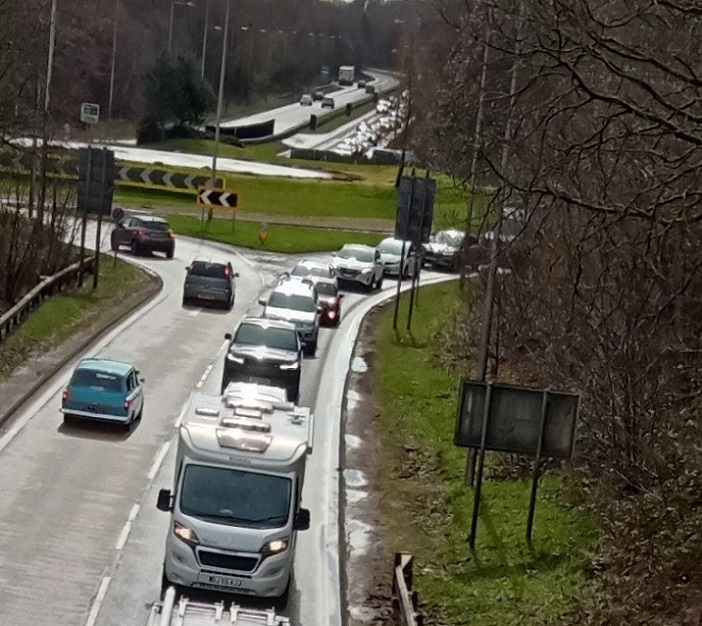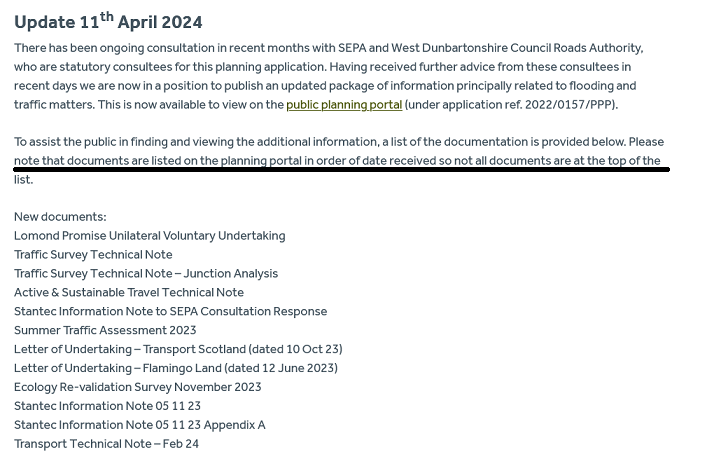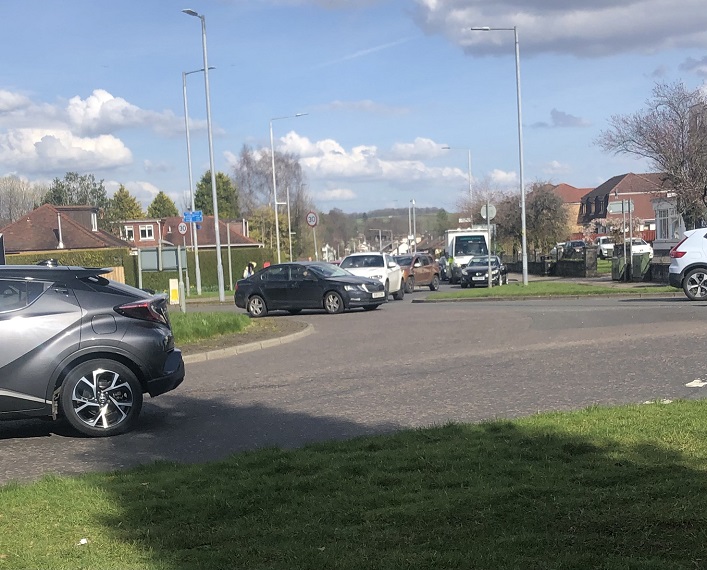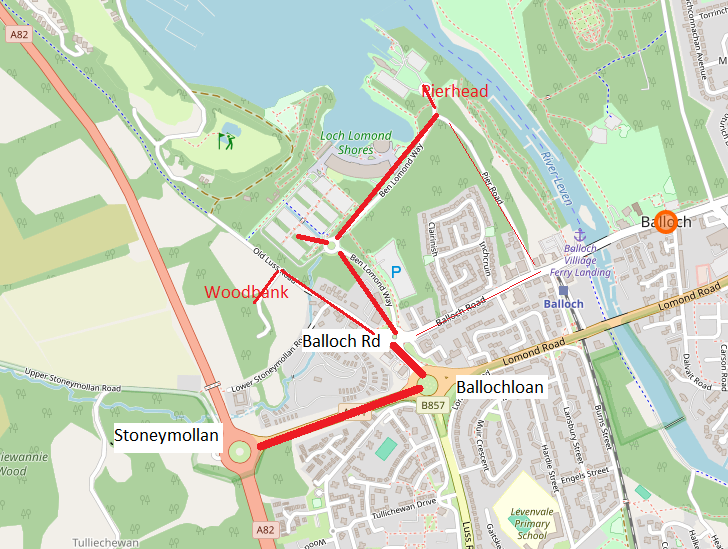
On 6th March “Lomond Banks”, the brand name Flamingo Land uses at Balloch, issued a news release (copy here) announcing it had finalised a Section 48 agreement [under the Roads (Scotland) Act 1984] with Transport Scotland under which it would pay for an upgrade to the Stoneymollan roundabout on the A82 should its planning application be approved. Transport Scotland’s name and logo are missing from the news release and they were not quoted either. To have done so might have drawn attention to what role they had played in this process and prompted questions.
I searched in vain for information about this on the Loch Lomond and Trossachs National Park Authority (LLTNPA) planning portal until, five weeks later, they published (see here) the following on their website tucked away under “major applications” where few are likely to see it:

The update shows that the reason it has been so difficult to find information relating to the Section 48 Agreement over the last few weeks is that the LLTNPA has been holding it back and also why it is still so difficult to find: the publication date, which automatically sorts information on the planning portal, has been backdated to the day the information was received rather than 11th April when it was actually made public. To add to the confusion the Letter of Undertaking from Flamingo Land to Transport Scotland, dated 12th June 2023 (see above), is shown as appearing on 10th November, presumably the date is was passed on to the LLTNPA.
This falsification of the public record serves to cover up the fact that the LLTNPA has been withholding information for months, depriving the public of the opportunity to comment. Moreover it strongly suggests LLTNPA staff have been party to some of the discussions that have led to the Section 48 Agreement, raising further questions about their “neutrality”.
The Section 48 Agreement itself has still not been published on the LLTNPA’s planning portal despite one its clauses (F) stating that “the Developer has advised the Planning Authority”. I know this because there are copies circulating in the local community (copy here).
Transport Scotland’s Section 48 Agreement with Flamingo Land
Key elements of the agreement are that:
- “the Roads Authority [i.e Transport Scotland] has been examining a potential solution to alleviate the Queuing Problem and has estimated the cost of delivering such solution to be in the region of ONE HUNDRED AND FIFTEEN THOUSAND POUNDS (£115,000) STERLING”;
- Flamingo Land has agreed to pay this sum of £115k (and it is “roads” inflation proofed);
- that Transport Scotland must carry out the works within five years of any planning permission being granted. This could mean the promised improvement won’t take place until AFTER construction of the resort is complete
There is no description of the proposed works or map included in the Section 48 Agreement and none have been lodged on the LLTNPA’s planning portal making it impossible to tell what improvements are planned or to be able to comment on them.
What is clear is that road improvements are costly and Transport Scotland won’t be able to do much for £115k.
Reasons for and implications of the Section 48 Agreement -Transport Scotland
As I explained 14 months ago (see here) both Transport Scotland and West Dunbartonshire Council’s roads department had been involved in and implicitly endorsed all the traffic assessments undertaken as part of Flamingo Land’s new planning application. Neither expressed any concerns about the traffic and parking implications of the proposed development. Local residents, visitors to Balloch and anyone who has tried driving the A82 at busy periods knew differently (photo above).
The local MSP, Jackie Baillie, picked up on this and it appears from Flamingo Land’s letter of undertaking that she helped prompt Transport Scotland into a re-think:

What is clear now, however, was that re-think has been extremely superficial with both Transport Scotland and Flamingo Land maintaining improvements to the Stoneymollan junction were “desirable not essential”. That is despite Flamingo Land upping their own estimated traffic impact to show as many as 253 vehicles during rush hour – that is one vehicle every 14 seconds.
This limited approach is demonstrated by the “Transport Technical Note” undertaken by Stantec, which was published on the planning portal in February and which reached the following conclusions:
“The results of the traffic assessment therefore shows that there would be a minimal traffic impact on
the operation of Stoneymollan Roundabout junction with the addition of development traffic [i.e from Flamingo Land] and the junction will operate within capacity during all peak hours assessed.”
AND
“In conclusion, as evidenced in the submitted TA and summer traffic assessment, the proposed
development will again not have a material traffic impact on the operation of either the existing
Stoneymollan and A811/Luss Road/Old Luss Road roundabout junctions”
The traffic planners therefore continue to see “material traffic impact” in extremely narrow terms and that means the only reason for the Section 48 Agreement is Transport Scotland wanted to alleviate concerns in the local community in order to pave the way for the planning application being passed. There is no evidence to suggest that that was Jackie Baillie’s intention when she intervened on behalf of the local community but that has been the outcome.
The significance of the Section 48 Agreement is not that it will change much but that it provides a tacit admission that Transport Scotland’s whole approach to traffic and roads capacity is wrong and the local community were justified in their concerns. While Transport Scotland may believe long queues of traffic are acceptable, anyone who has been stuck in queues in Balloch or on the A82 on a sunny bank holiday weekend knows it makes no sense at all to build a development that will bring yet more traffic to the area.

The front page of the agreement shows it has been endorsed at the highest level. This raises important questions about the Scottish Government’s role in the planning system. If the Transport Minister can use their powers to reach an agreement which appears designed to persuade the local community to accept increased traffic in Balloch, presumably the Minister for National Parks is equally free to use her powers to prohibit any of the land owned or leased by the LLTNPA in Balloch being used for purposes that might increase traffic levels and make it more difficult, for example, for boat users to access the Duncan Mills slipway at the pierhead (the one remaining public slipway on Loch Lomond).
The Scottish Government cannot have it both ways: either every Minister except the planning minister (who determines appeals) is free to take action to support or block a development or they are not.
West Dumbarton Roads response to the planning application

West Dumbartonshire Council (WDC), is responsible for the other roads and parking in the Balloch area and has rejected the conclusion (see above) that the Ballochloan roundabout could cope with the additional traffic attracted by the development. While the technical report accept that Flamingo Land would create more queues it argued that because “at no point will the queue [from the Ballochloan roundabout] extend back to the Stoneymollan roundabout junction” – creating further traffic chaos on the A82 – no improvement to the Ballochloan roundabout was needed. WDC has used information from Stantec’s technical report to reach the opposite conclusion:
“the A811 (W) approach [is] operating at 1.13 RFC [Rate of Flow Over Capacity] which is well above the theoretical capacity of 0.85 RFC. The junction modelling shows that the junction is currently operating over capacity and that mitigation on the A811W approach is required to improve junction performance.”
This represents a significant reversal of WDC’s initial response to the planning application about the impact of traffic attracted by the proposed development on Balloch and goes further than Transport Scotland in stating that traffic will be over design limits – at one particular spot. Its response recommends that a new slip road be created between the A811 West and the Old Luss Road and that this should be implemented by means of a planning condition, rather than a Section 48 Agreement.

The WDC’s reversal of its position is, however, based on technicalities and limited to capacity issues at just one junction not an assessment of the wider impact that increased traffic might have on local amenity. Indeed had the LLTNPA – as a result of public pressure and Jackie Baillie’s intervention – not asked Flamingo Land to undertake a further traffic assessment it appears likely WDC would not have made any further comment on the development from a roads perspective. A good illustration of this is that is has made no comment on the traffic implications for the Balloch Rd roundabout – which provides the main vehicle access point to Lomond Shores and to the proposed development – because that is not included in Stantec’s Technical Note.

Despite acknowledging that “It is widely known that the summer season, good weather weekends and local events can increase traffic significantly on the A82, A811 and the local roads, all to the detriment of the local area” the Council in its response raises no objection to this being made worse. It is as if to WDC all the policies in National Planning Framework 4 about the importance of place, reducing carbon emissions, encouraging used by public transport don’t exist.
As a final twist, in June 2019 WDC unanimously agreed to object to the original Flamingo Land planning application even though their roads department had raised no concerns about traffic levels. Now, however, even though WDC formally accepts the increase in traffic will be to detriment of the area, its officers are recommending to councillors they should back the development. No wonder there is uproar in the local community and they are asking people to protest at the WDC meeting next Wednesday (see here).
What needs to happen
Transport Scotland’s Section 48 Agreement and the response by WDC to Flamingo Land’s traffic assessments epitomise the extremely narrow approach that roads authorities take to the impact of traffic on people and the environment. Their primary concern continues to be traffic flow (and road safety) and they appear to have made no changes to this despite all the other policy talk about the need for greener transport and greener places. With Roads Authorities failing to change their practice, it is little wonder that the Scottish Government had to abandon their targets for achieving reductions in carbon emissions last week. Targets just don’t magically happen and will never be met unless public authorities change what they do.
Whether targets exist or not, if we are to address the climate and nature emergencies our roads and planning authorities should stop facilitating developments that will generate increased traffic. Unfortunately, Transport Scotland, WDC and the LLTNPA appear to be doing the opposite at Balloch when what they should be doing is developing better public transport.
The LLTNPA now needs to set an example as a National Park and rectify these traffic and parking failures. As a start it should address flaws in the planning process to date, including:
* committing publicly to publishing any further documents it receives relating to the Flamingo Land application timeously and stop acting in ways that favour the developer as it is doing at present;
* requiring Transport Scotland to submit full plans of what it intends to do at the Stoneymollan roundabout together with an explanation of what the “improvements” will achieve;
* conducting its own assessment of the impact that increased traffic on local amenity, including parking, given WDC’s failure to do so and publish these in time for the public to comment BEFORE it refers the application to the Board for a decision.
Getting people into cars to drive to an overdeveloped loch-side site , where most of the money spent will be siphoned off by a large corporation. A few zero-hours jobs (subsidised by the tax payer) and almost zero benefit to the community playing host to a frivolous development no one wants.
What on earth are our supposed elected REPRESENTATIVES playing at?
This is very much a pattern in Scotland with the local community acting as spectators whist the wealthy and powerful consume and degrade our landscape, then make off with the profits. It is in no way sustainable or sensible.
As a frequent user over many years of the A82 between Arden roundabout and Balloch and vice versa, it is my opinion that tinkering with Stoneymollan roundabout will create even more problems than currently exist. The bottom line is that the infrastructure of the A82 is insufficient to meet the needs of the public …. at any time never mind during the tourist season. As the main west coast route north /south it is a disgrace as so much of it is two-way traffic only, and much of it very narrow. One of the problems at Stoneymollan is that the road heading north from Dumbarton is dual carriageway leading on to simple two-way infrastructure at Stoneymollan, which in turn causes the traffic back-ups on the A82 heading north to Stoneymollan. It doesn’t need much of a brain to work that one out! Similarly, heading south along Loch Lomond-side tailbacks frequently start at Luss. This, I imagine, will only become even worse as the ‘improvements’ to the Tarbet picnic area by LLTNPA are completed and potentially attracting even more day visitors. Even outwith the tourist season one can encounter these issues at any time, but especially at commuting times. Many of the traffic management ‘solutions’ around the Balloch and Stoneymollan areas are ill conceived as per the photos of Balloch. Stoneymollan roundabout is a death trap for people coming from Balloch and heading round it to the A82 to go north. A number of years ago tall iron fencing was erected between the barriers on the dual carriage-way approaching Stoneymollan roundabout thus restricting the view of drivers approaching on the A82 and also those joining the roundabout from Balloch. Add to that the seeming reluctance of many drivers on the dual carriage-way to slow down (never mind stop!) on their approach to that roundabout. It is already an accident waiting to happen as it is never mind any ‘improvement’ proposals by Flamingoland!
It seems to me that those who sit in offices and make these sort of decisions about traffic flows on arterial routes in Scotland are never the ones relying for their whole economic existance the pieces of vital infrastructure they hold authority over.
Can it really be that TS Road engineers do not understand that because long ribbons of land, often less than 30 ft wide, connect the west Highlands to Glasgow, all routes north and south pass along it.
It does not take much to cause a hold up. The Stoneymolen rondabout leads to the very first bit of “dual carraigeway” Highanders ever see as they drive south. Nick is quite right to highlight the capacity dangers of this roundabout.
In truth, we can assume this place, with its unnecessary park “Bling”, arguably stands at the outer limits of TS official concerns. It may well be seen as the furthest north piece of road senior Transport Scotland officials think they need to care about?
Such places as Rest and be Thankful, or Tarbert Inverarnen is somewhere there’s nopo real need to go ? “Beyond their ken!”
Decades pass and still no real energy is ever given to producing long term solutions for West highland traffic flows . Setting out now to help ensure this much reworked, “outer limit of imagination” roundabout functions even worse than at present, simply beggars belief.
Having lived at the Arden roundabout for 25 years I have had time to reflect on the A82.
Rarely have i been held up or prevented from reaching my home heading north from Stoneymollan. It’s not an issue! What is an issue heading north is the right hand turn into Duck Bay . Tourists get confused and their erratic driving shows that.
Similarly turning right to head north on the A82 from Duck Bay is one manoeuvre I just don’t do.
For safety there should either be lights, roundabout or prohibition of that right turn on to the A82.
The A82 north of Tarbert requires to be upgraded immediately to a decent single carriageway. with well publicised traffic camera management to stop the idiots both the speed merchants and the go-slows.
Heading south from Tarbet the issue is a build up of cars heading for Stoneymollan. Although i’m usually going in the opposite direction from the Queues iin virtually every occasion i’m heading south in the queue it dissipates once I’m up the hill and isn’t a big inconvenience.
What would help is an overtaking lane up the hill at Cameron House up to Stoneymollan. There’s ground there to do it. Slower vehicles like log lorries and weekend drivers could be passed.
Overhead signs on the approaches to Stoneymollan would give drivers more warning of lane rules.